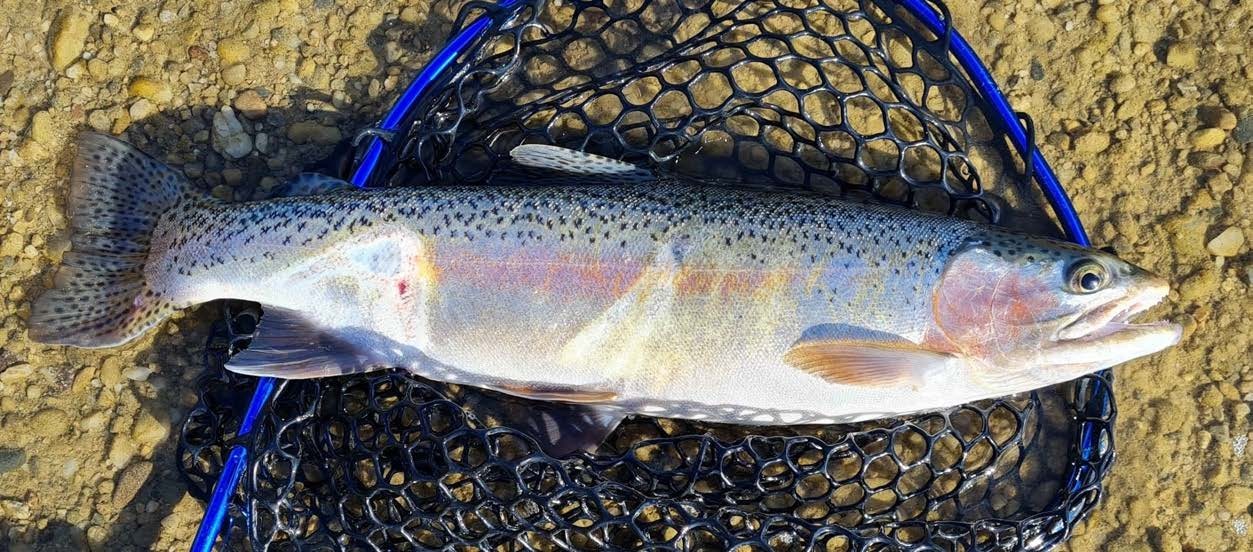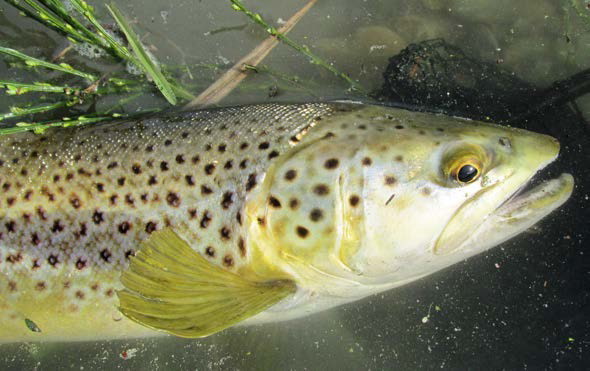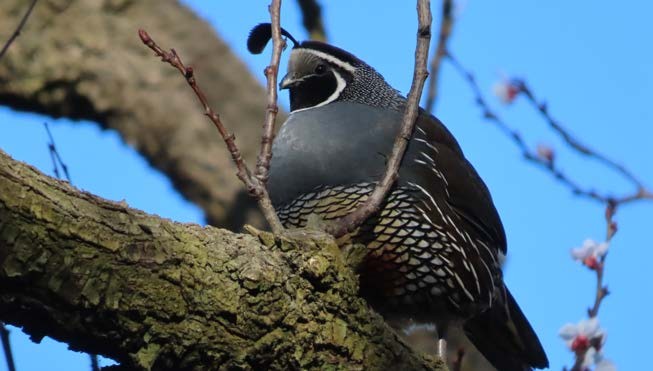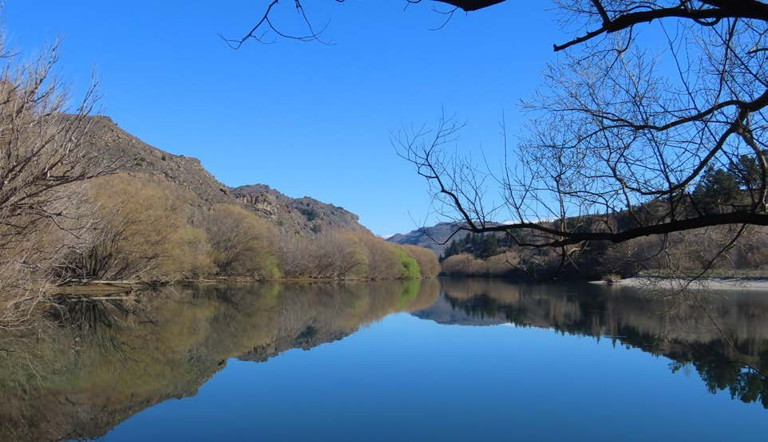TROUT FISHING AT THE END OF GRAVEYARD GULLY ROAD
■ By Greg Morton
Recently, while looking for some new trout water near Alexandra I found myself parking up at the end of Graveyard Gully Road. Yes, there is a small historic graveyard named Pioneer Cemetery located here, and yes, it sits in a gully that runs down to the Manuherikia River. From here I walked down a boundary fence which gave me access to the river. The rocky Knobby Range towered behind me.

A returning spawned rainbow jack.
On the other side of the fence was a property I remembered from my teenage days as Sanders Orchard. It is unique because two respected fishing rivers border the land. The house and orchard overlook the confluence of the Manuherikia and Clutha (Mata-Au) Rivers on the true left bank.
Once the two rivers merge, the enlarged current then enters the top end of Lake Roxburgh. On the other side of the Manuherikia River is Alexandra, while further upstream on the Clutha is the Alexandra Bridge and Clyde Dam, and downstream is Roxburgh Dam.
On my fourth cast of the day I met the first of two locals who know these rivers well. Local number one went by the name of Jack. A jack rainbow trout to be precise, and he announced his arrival with a solid bite. After a short battle he was landed and I was surprised he had the energy to whack my Panther Martin spinner. His body was beaten and battered and he looked like he had escaped from a washing machine on high spin. He was a spawning fish just returned from his annual propagation mission and frankly he looked lucky to have survived the mating trip.
Several decades back it was extremely uncommon to meet any rainbows in this area but not now. They are often encountered in both rivers and some can reach a surprising size. His epic mating sojourn would have taken him to some distant location in the headwaters of the 85km long Manuherikia River, probably somewhere up in the St Bathans Region where there are a few feeder streams.
Spawning is a tough process and his body was covered in survival scars. His tail fin was worn and his body was lean. I felt only respect for his dogged determination to live so took a quick photo of him lying on my net before releasing him back into the river he knew so well.

Brown trout caught on a willow grub.

A Californian quail in a Moorpark Heritage Orchard apricot tree

Lake Roxburgh.
The Manuherikia River I was fishing in is also worthy of the title ‘battler’. It is officially described as a stressed river because over summer it shrinks alarmingly as it flows downstream. It suffers floods, droughts, silting and high irrigation needs but, like the rainbow jack I caught, struggles on in the face of adversity. It is an important river to the region and has a long history of providing water to gold miners, farmers, orchardists, swimmers, and anglers and is a home to wading birds, waterfowl, and fish. No decision on how to ‘de-stress’ the river has yet been unanimously accepted by all stakeholders.
After releasing the warrior trout, I met my second local resident of the day. Mike Hughes had seen me fishing and hopped the boundary fence for a chat. He and his wife Fiona are the present owners of the orchard. It now goes under the name Moorpark Heritage Orchard and they are the second owners since the Jerry Sanders days. To those not up on their fruit, a Moorpark is a quality apricot variety and those planted here have heritage status because of their impressive longevity, quality, and tree size. Those lucky enough to eat some of the fruit from here say they taste like a true apricot should.
Mike and Fiona had spent numerous summer holidays in Central Otago and through coincidence and good fortune found themselves the new owners of this very special riverfront property. It was meant to be and has now been their home for several years. The treescape, bird life, river and hill views, and charm of the place were decision-tipping features.
They have taken a ‘gently, gently’ approach to their ownership of the property, and a custodial interest in the confluence rivers and creatures that surround their home. There is a resident covey of Californian quail living in the willows and a bush falcon often visits seeking to ambush small birds visiting the orchard. A protection of the environment attitude prevails here and the retention of the senior citizen apricot trees is a case in point.
Mike works with the local Regional Council, the District Council, and Contact Energy concerning matters such as water quality and silt removal and no one has a better frontrow seat for observing the daily health of the rivers. Recently Wilsons Contracting, working for Contact Energy, removed some 73,000 cubic metres of gravel and sediment from the lower Manuherikia River to ensure the main riverbed was well defined and deep.
Moorpark Heritage Orchard has no King’s Chain access rights so wandering riverbank anglers are restricted to fishing down to Mike’s private land boundary then starting fishing again from the Lake Roxburgh Walkway track which can be accessed from the cemetery car park. On the Alexandra side of the Manuherikia River there is a Fish & Game access road.
Mike said the most obvious fish species at the confluence on the Clutha side were brown trout of about 1.5kg living under the willows and rainbows out wider in the glides and deeper water. The browns cruise the tree edges and angler friends of his target them in gaps in the trees. Similar gaps do appear regularly below his property, all the way down to the Lake Roxburgh narrows and beyond. Willow grub imitations work well in summer. On the Manuherikia River side of the confluence the brown trout are smaller but feisty, and occasional redfin perch – some quite big – are also caught. Angler guests who stay with the Hughes can never fully relax as fish spasmodically rise down below the house all day long causing the anglers to regularly scurry off “to have one last cast.” It never is just one cast.

The Manuherikia and Clutha River confluence.